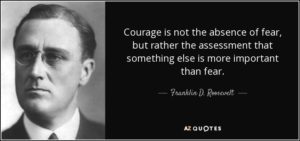Mary E. Marshall's Blog, page 24
September 12, 2017
Small Business -The Heart of Our Economy
 “Mattress Mack” of Houston, Texas
“Mattress Mack” of Houston, TexasAs I watched the horror of Hurricane Harvey unfold on the people of Texas, as well as Irma barreling down the Caribbean towards Florida, I couldn’t help but think about all those people who lost everything and the devastation to their lives as a result. Of course, I also thought about all those small businesses who will also need to recover and won’t necessarily have the resources that the larger businesses will have. My heart goes out to all those who have been affected by these devastating disasters.
And then I read about the owner of the mattress store known as “Mattress Mack” who opened up his stores as shelters. This is why small business matters. It is of little sacrifice or consequence for large businesses to help in times of need – they have provisions for “rainy” days, (no pun intended), and deep pockets to carry over for business loss or interruption. They have funds set aside for donations and community outreach and it’s often a small decimal point on their bottom line. Don’t get me wrong, community support from our large employers is absolutely needed and much appreciated, but the impact on their ability to run is very different than for small business owners.
The difference is that small businesses generally don’t have the savings or provisions for these sorts of disasters and yet, give way beyond their means. The percentage of their bottom line as contributions, aid, and donations is much, much higher. The generous mattress store owner saw a need and did what he could to ease his communities suffering. He opened his stores as shelters, letting people sleep on the brand new beds not worrying about the cost. This was generous, small business entrepreneurship at its finest.
Small businesses employ 72% of the workforce in the United States. They provide benefits beyond what they can afford in most cases because they know how important it is for workers and their families. I’ve seen multiple owners go without pay to make payroll for their people. I’ve seen them give donations of time, money and products when they were barely breaking even. They care. They care about their employees, their communities, and all the families.
Some small businesses become large businesses and that’s when they seem to lose some of their heart. When the focus is on shareholder value rather than the people whose lives contribute to the business operating successfully, things change. The employees become a means to an end rather than part of something bigger than themselves. When is the last time a CEO of a Fortune 1000 company went without a salary? Opened up his businesses and gave things away because they were needed? Did the right thing, just because it was the right thing to do?
Let’s celebrate all those small businesses that are the engine of our economy, that provide opportunity for so many and that provide the heart and soul of so many communities. Let’s thank the mattress store owner for showing us his humanity and doing what he could to help his community and showing us the real spirit of entrepreneurship through giving.
The post Small Business -The Heart of Our Economy appeared first on Mary Marshall // CEO Coach.
September 6, 2017
Designing Your Organization for Success
 When I work with an organization, I look at a lot of things. Over the years, however, I’ve come to believe the fundamental “design” of the organization is the key to its success or failure. This is actually a little different than Organizational Development or “OD” as it’s known. OD is a deliberately planned, organization-wide effort to increase an organization’s effectiveness or efficiency.
When I work with an organization, I look at a lot of things. Over the years, however, I’ve come to believe the fundamental “design” of the organization is the key to its success or failure. This is actually a little different than Organizational Development or “OD” as it’s known. OD is a deliberately planned, organization-wide effort to increase an organization’s effectiveness or efficiency.
Design is how the organization is set up. Yes, it involves the organizational chart or “org chart,” but it’s how it’s put together that allows a company to thrive or wither. Think of it like StrengthsFinders 2.0, the work by the Gallup organization that posits that everyone has strengths that can be grown into talents. Strengths are the natural areas of ability that people thrive in if practiced or nurtured.
The strengths required for each position in an organization need to be matched to the right individual and the structure around that person needs to be matched to his or her development needs. It goes something like this:
At the foundation, start with the values of the organization.
Then start looking at what the organization requires for its product or service to be sold and delivered profitably.
Next, you create positions with strengths identified that if developed into talents, would make the individual and the company successful.
This is done for each department. It is tested continuously until you have the right “mix” for the batter.
Next create the management structure that supports, nurtures and trains these “strengths” to tease out the talent. You also need to do the same for the management.
In its simplest form, it’s about having the right people on the bus, in the right seats, (as author of “Good to Great” Jim Collins would say).
It’s rare that you see an organization with the organizational design right and firing on all cylinders and it takes a while to get there, through lots of trial and error. But when you do, it all comes together like beautiful music being played by a world class symphony orchestra. I’ve worked with a couple of companies in this position and it’s really thrilling to see the collaboration, lack of ego and the enormous amount of work being accomplished. What one client company had not been able to do in 20+ years, they have achieved in the last three. It’s like a new company. They have the battle scars to prove it, but the future is theirs for the taking – and they are having so much fun!
It’s what entrepreneurial companies are all about – trying new things, teaching, learning, collaborating, competing and at the end of the day, winning. All big companies were small once, and if you get the Organizational Design right, you’ll create a big company and launch people in the process. The design and people are the heart of the matter, the product always comes second. If you get the design right and the right people in the right positions your business will thrive!
The post Designing Your Organization for Success appeared first on Mary Marshall // CEO Coach.
August 29, 2017
Why Intentional Leadership Matters
 What if we valued leadership skills as much as we value a degree in medicine? Think about it. Is there a graduate degree for leadership? Not really. There is an MBA which is often equated with someone being able to lead, but it’s really about understanding business theory and working through case studies about how business actually works. There are PhDs for Leadership Development meaning the development of others or organizational development, but not for leadership per se. There isn’t a standardized degree program with an accompanying set of initials that we all recognize like “M.D.” to indicate someone has an advanced degree in the art of leadership.
What if we valued leadership skills as much as we value a degree in medicine? Think about it. Is there a graduate degree for leadership? Not really. There is an MBA which is often equated with someone being able to lead, but it’s really about understanding business theory and working through case studies about how business actually works. There are PhDs for Leadership Development meaning the development of others or organizational development, but not for leadership per se. There isn’t a standardized degree program with an accompanying set of initials that we all recognize like “M.D.” to indicate someone has an advanced degree in the art of leadership.
I think the reason is because so many leaders end up being in a leadership position for one or more of the following reasons:
Only one who showed any willingness to take on the role
Longest one at the company or the organization
Biggest schmoozer on the board or among decision-makers
Best salesman or woman of themselves
Has the most money to advance themselves or donate to the right person
Accidentally in the right place at the right time
Relative of the decision-maker
Best of the bad choices/candidates available
Most of these are a “default” in some way and none of them is particularly positive. The result? Most organizations’ leadership is somewhat accidental and often unintentional. As I’ve discussed in my book and in my talk on Intentional Culture, intention can make the difference between success and failure in an organization, so putting some intention on the leadership is critical.
This means deciding what makes a good leader for the organization. What background and knowledge do they need to have? What temperament will fit with the organization’s style, mission, vision and culture? What skills do they need to have to bring the vision to reality? It’s as much about character as it is about skills. We’ve all experienced the train wreck that happens when the best sales person is promoted to the sales manager. Selling and leading others to sell are different yet equally important skills. We conflate the two all the time to the detriment of the person being promoted and those they will lead.
If we were intentional about training and supporting leaders, for each organization it would be a bit different. Boards and advisors would be set up to help, not to “check” the performance of the leader. Vision of the organization would be paramount, not the pay package or the leader’s golden parachute. Money would not influence, but would be a reward for the company doing well.
Next time you think about promoting someone into a leadership role consider the following:
Do they truly want a leadership role?
Have they demonstrated the ability to get work done through others?
Have they shown humility?
Do they have the respect of the team?
Are their values aligned with the vision and the organization?
What support/training will the organization make available for them to be successful?
If you are clear on some of these questions, maybe, just maybe, you’ll create an Intentional Leader.
The post Why Intentional Leadership Matters appeared first on Mary Marshall // CEO Coach.
August 23, 2017
Values, Firsts, and Making an Impact in 3 Seconds
 WSU Elson S. Floyd College of Medicine inaugural class
WSU Elson S. Floyd College of Medicine inaugural classI had the great privilege this weekend to attend the White Coat Ceremony for the inaugural class of medical students for the new WSU Elson S. Floyd College of Medicine in Spokane.
As I listened to the speeches I was struck by Dr. John Tomkowiak’s inspirational keynote address. As the dean of the new school, he asked all the students to list their values or priorities in order of importance. On cue, they recited “health, family and friends and school.” What better way to set these bright and eager minds up for success? If they are not healthy, how can they treat others? If they do not prioritize their family and friends, how can they treat people with care and empathy? If they do not make school a priority, how will they learn all they need to learn to take care of all of us? The order was significant and it was not lost on those of us who were parents in the audience.
As these 60 young people go through the next 4 years on their journey to residency and then to becoming doctors, I hope they realize what a gift they have just been given. At the beginning, they were told what and how to prioritize their next 4 years – the foundation for their learning and growth. With the guidelines, it will be easier for each of them to stay on course and know how to make decisions going forward.
Two other points Dr. T made were also significant. First, he emphasized the importance of “3 seconds.” What can be accomplished in this short period of time? You could apply a tourniquet and save a life, you could clear an airway and save a life, you could set a bone and save a limb. What if business leaders thought about this? In 3 seconds what leadership impact can you have? Actually, a lot. How many decisions are made that quickly? You could also inspire someone to action, make a difference in a life, help someone achieve their dreams.
The second point he made was that life is a series of firsts. This was the first class of the new medical college and this will lead to a 1000 more firsts. So, this class has an obligation to make it meaningful, make it worthy and to pay it forward. They will get to be first and more importantly, pave the way for those who follow.
As leaders, how are we making it easy for all those who follow to have firsts? How can we move out of the way to let those we lead create their own path? By providing a foundation in values that sets the course to follow, we make it much easier.
I also want to personally thank Elson S. Floyd and all those who made his dream come true for providing a path for my son to follow in medicine.
The post Values, Firsts, and Making an Impact in 3 Seconds appeared first on Mary Marshall // CEO Coach.
August 16, 2017
Improv – Not a Great Leadership Strategy
 Improv comedy makes great theatre and for anyone who has seen people perform it well, it’s hilarious. Improv also works to help bring people out of their shells and helps them get over stage fright. Improv could also be a great strategy for innovation when gathering ideas and trying to find solutions to problems. But improvisation as a leadership strategy? Not so successful and here’s why – leaders are looked to for stability, to be the adult in the room, to reassure their followers that they are “safe,” and to emphasize that whatever decision or message being delivered is the right one. Every single word or action of the leader is watched, interpreted and dissected for meaning. Whether the action or words had meaning or not, one will be assigned. For leaders, words and actions are the legacy of leadership.
Improv comedy makes great theatre and for anyone who has seen people perform it well, it’s hilarious. Improv also works to help bring people out of their shells and helps them get over stage fright. Improv could also be a great strategy for innovation when gathering ideas and trying to find solutions to problems. But improvisation as a leadership strategy? Not so successful and here’s why – leaders are looked to for stability, to be the adult in the room, to reassure their followers that they are “safe,” and to emphasize that whatever decision or message being delivered is the right one. Every single word or action of the leader is watched, interpreted and dissected for meaning. Whether the action or words had meaning or not, one will be assigned. For leaders, words and actions are the legacy of leadership.
When messaging and actions are “off-the-cuff” and improvised, mistakes can be made, contradictions happen and followers are left wondering what to believe or to do. Like the childhood game of whipsaw, if you’re at the end of the rope, as a follower, you’re likely to be whipped off. After multiple such whips, the leader loses the confidence of their people and they will stop following.
In an organization, the phrase “steady at the helm” is appreciated. When a leader behaves with steadiness, the team performs better. When the leader has done his or her research and is informed before speaking or making decisions, the followers are assured that the direction is the right one. When the speech or actions are not thoughtful and are just “in the moment” they can come across as disconnected and people can be unsettled and lose faith in the leader’s ability to achieve objectives.
As a leader of your organization, it’s on you not to be the improv comedian. Leadership is not funny. People are not looking for you to surprise and delight them, they are looking for you to lead. To know what, why, and where things are going and to share clearly “what’s in it for us” to the employees. Occasionally, the organization may be delighted, but only if the words are followed by actions that reinforce the statements and are consistent with the overall mission and objectives.
Leadership is also not about the leader per se. It’s about what the leader does, what strategies are employed, and how people are treated. It’s about purpose – whatever strategy, goals, and objectives are serving the greater good of the organization. “Level 5 leadership” as Jim Collins talks about in his book Good to Great defines the leader as humble. Humble leaders are thoughtful, careful and curious. Words and actions matter. To paraphrase a Chinese proverb – when the leader is finished, the people say it happened naturally. No improv involved.
The post Improv – Not a Great Leadership Strategy appeared first on Mary Marshall // CEO Coach.
August 9, 2017
Can This Culture Be Saved?
 “It takes many good deeds to build a good reputation, and only one bad one to lose it.” ~Benjamin Franklin
“It takes many good deeds to build a good reputation, and only one bad one to lose it.” ~Benjamin Franklin
In September of 2016, it was disclosed that Wells Fargo had created 2.1MM fake or fraudulent accounts to meet sales targets. The leaders involved at the time were let go with fat paychecks, but the CEO was only let go 6 months later after public outcry threatened to tank the stock even further. I wrote about it at the time and called it not only a failure of leadership but a prime example of a corrupt culture that rewarded fraudulent behavior. It was one of the biggest PR black eyes of 2016. Millions were paid in restitution and 5K employees lost their jobs for doing what the company rewarded them to do.
The board claimed the company was not living its values (duh!) and that it was a momentary lapse in an otherwise spotless record as a good corporate citizen. They made assurances that they had righted the ship, made replacements, and nothing like that would ever happen again.
I was fascinated watching the company spin the story. Rather than call what happened opening fake or fraudulent accounts, or cheating, they called it “aggressive sales tactics.” This spin did not even come close to naming what actually happened – fraud and stealing from innocent customers.
Now, Wells Fargo is in the news again, for you guessed it, fraud. This time they tacked insurance on to car loans that customers did not ask for nor did they need. When they didn’t pay for the insurance, Wells Fargo had their cars repossessed. The number of people given insurance they didn’t need? 490K. Another example of “aggressive sales tactics?” It’s time to speak some truth here, this a culture gone very wrong.
Charging customers for things they did not ask for has become their way of doing business and their culture continues to reward this behavior. Ultimately, it doesn’t seem as if anything at the bank has changed. The sheer volume of the new fraud indicates that multiple people likely knew this was going on. Where were the watchdogs? Why didn’t the board and leaders put processes and procedures in place to make sure this type of thing didn’t happen again? Here’s the reality. They were watching their share price rise and they were willing to do whatever it took for that to continue.
Culture is set at the top of an organization, embraced by the middle, and lived at the bottom. People were behaving in alignment with the current culture. Wells Fargo needs a cultural reset and that starts with saying goodbye to the board and cleaning house of upper management. Until then, the next scandal is right around the corner.
Image credit: By The original uploader was Henry W. Schmitt at English Wikipedia (Transferred from en.wikipedia to Commons.) [Public domain], via Wikimedia Commons
The post Can This Culture Be Saved? appeared first on Mary Marshall // CEO Coach.
August 2, 2017
Courage is Not the Absence of Fear
 There is a quote from Franklin D. Roosevelt that says, “Courage is not the absence of fear, but rather the assessment that something else is more important than fear.”
There is a quote from Franklin D. Roosevelt that says, “Courage is not the absence of fear, but rather the assessment that something else is more important than fear.”
We have a “fearless” business culture that encourages bravado and says go for it or else you’re weak. I’m going to suggest we might want to take a step back before going for it. Fear is actually a healthy thing and not a sign of weakness. It is a primal signal that says danger might be present, or harm might be imminent. Lack of fear in the face of danger is not courageous, it’s reckless and can lead to negative consequences.
As Roosevelt says, courage is moving forward towards something more important than the fear. Courage is doing the right thing when no one is looking when no one will ever know. Courage is making a decision that may not be popular in the short-term but ultimately will be for the greater good in the long-term.
Entrepreneurs are faced with many such decisions on a daily basis. Naturally more inclined to take risks than the average person, they have a high tolerance for risk. But the savvy leader recognizes fear and its value. Leaders who have no fear continue to make terrible decisions and don’t worry about the consequences. Sometimes they even assume that the pieces will just be picked up by someone else. Most entrepreneurs don’t have that luxury – a big mistake can mean the shuttering of the business.
But fear can also be paralyzing for the entrepreneur – the fear of a wrong choice or a bad decision can paralyze the leader into indecision. Indecision by a leader is one of the most highly reported complaints by employees and will cause them to leave.
So how do we embrace courage if we have not been on the front lines for a while? The answer is “purpose.” The reason people are courageous and move beyond their fear is the “why.” Why are we doing this? What is the purpose? People will follow you all day long if they buy into the “why” of the proposition (for more on this see Simon Sinek – Start with Why) versus the “what.” Leaders get so caught up in explaining the “how” and the “what” of something that they forget to explain the purpose. The only way people will make a decision to follow is if they know the why.
Next time you feel that fear – of failure, humiliation, danger, loss, indecision, etc. – think about what is most important. Courage is getting on the other side of that and leading the way. John McCain did just that last week with his “no” vote on the proposed health care legislation. That’s courage.
The post Courage is Not the Absence of Fear appeared first on Mary Marshall // CEO Coach.
July 26, 2017
The Self-Aware Leader
 Emotional Intelligence can often be underrated when talking about leaders. We tend to value the stronger and more obvious “leader-like” traits such as confidence, decisiveness, and charisma. Emotional Intelligence or “EQ” starts with self-awareness and as Daniel Goleman points out in, “Why Self-Aware Leaders Are More Productive and Effective,” self-aware leaders are often much more productive than their peers.
Emotional Intelligence can often be underrated when talking about leaders. We tend to value the stronger and more obvious “leader-like” traits such as confidence, decisiveness, and charisma. Emotional Intelligence or “EQ” starts with self-awareness and as Daniel Goleman points out in, “Why Self-Aware Leaders Are More Productive and Effective,” self-aware leaders are often much more productive than their peers.
The adage “know thyself” is really what self-awareness means. If you don’t acknowledge both your good and bad traits, your character or skills, how can you build on those? The first step to this is to listen. Stop interrupting and interpreting what others tell you and really listen to what they have to say. Behavioral change can only start from an accurate assessment of what really is. Think of it like a car repair. If the car won’t start and the diagnosis is the battery has gone bad and you replace the starter, it still won’t start. If you are not self-aware and someone tells you that you don’t listen or that you aren’t empathetic and people perceive you as aloof, you will likely dismiss the feedback – precisely because you don’t listen and are not empathetic. Your response is likely to be negative to the person giving you this feedback rather than looking inward to consider how you might change.
Lack of self-awareness is more than a blind spot – we all have those. It is an inability or unwillingness to confront who we are or how we are seen. If we continue to be unaware, no other leadership traits will matter because we have an inaccurate perception of our strengths and weaknesses.
Think of it like the airplane instructions – put your own oxygen mask on first. In order to lead others, you must first look in the mirror. Working from a false sense of self will only lead to more falsity, which in turn leads to more unproductive behavior. It’s a vicious circle.
To begin the process of building your EQ skills and self-awareness, start by simply asking people how you are perceived or conduct a 360. You’ll get to see the gap between your view and that of your peers and direct reports. The greater the gap, the greater your lack of self-awareness. Just acknowledging the gap is a great starting point.
Great leaders know their strengths and their weaknesses. Self-awareness becomes the foundation for productivity because you begin to understand what skills you need on your team to create strength in the areas that you are weak. Take a hard look in the mirror and really see what others see. It’s a great start toward emotional intelligence and good leadership.
photo credit: Mediocre2010 emotional via photopin (license)
The post The Self-Aware Leader appeared first on Mary Marshall // CEO Coach.
July 19, 2017
Avoid the Epic Leader Fail
 A great piece in Inc magazine recently reminded me of what leaders do wrong on a regular basis – “drive” for performance instead of “lead.” The author Marcel Schwantes makes a great case for why people don’t want to be driven like cattle. If we think about some recent leadership failures, for example, Uber, you’ll see what he’s talking about.
A great piece in Inc magazine recently reminded me of what leaders do wrong on a regular basis – “drive” for performance instead of “lead.” The author Marcel Schwantes makes a great case for why people don’t want to be driven like cattle. If we think about some recent leadership failures, for example, Uber, you’ll see what he’s talking about.
So how can leaders lead vs. drive? Schwantes identifies three very easy things that successful leaders do to start:
They facilitate a shared vision
They share power and release control
They share leadership by pushing authority down
Telling people what to do rarely works well in the long-term. You can get people to do what you say simply because you have positional authority but after a while, people feel “driven.” As I’ve often said, engaging people in your shared vision or “purpose” will let them decide how they will be on board and help, versus being forced to. It’s always more powerful when someone decides on their own to ride the bus versus being shoved onto it involuntarily. Think of the first time you put your kids on the school bus, not a pleasant experience! Get people excited about where you are going, what role they will play and why they might want to join you. The WHY of the whole thing is much more motivating than “because I said so.”
Successful leaders don’t hoard control. They know that sharing power and releasing control lets people make the best decisions because they feel empowered to be a part of the solution. Keeping control disempowers your team from doing their best and over time they feel a sense of helplessness because no matter what they do, they have to wait for you to approve. Not only is this demoralizing, it is expensive because it’s the least efficient way to run a company.
Lastly, good leaders push authority down. Let others make decisions and hold them accountable for the results. You will only grow good leaders if they have an opportunity to lead themselves. If you keep all the authority, the buck always stops with you, and your people will never quite know what is their responsibility and what is yours.
Bottom line, growing leaders is about sharing and showing good leadership. You must demonstrate what you want in the workplace and how a good leader leads. Unfortunately, we have seen some very public, epic leadership fails lately and not as many on the other side of the scale. You can start by leading your employees with a culture that fosters a shared vision and power and not a cattle drive for performance.
photo credit: Jayembee69 Followed by the herd at Chipping Norton via photopin (license)
The post Avoid the Epic Leader Fail appeared first on Mary Marshall // CEO Coach.
July 11, 2017
Your Employment Pipeline
 With the employment market tightening up, especially here in the Seattle market, it’s a good time to see what your pipeline looks like. What? You don’t have a pipeline? That’s the response that I get 99% of the time when I talk with small to mid-size company CEOs, so if that’s your response, you’re not alone.
With the employment market tightening up, especially here in the Seattle market, it’s a good time to see what your pipeline looks like. What? You don’t have a pipeline? That’s the response that I get 99% of the time when I talk with small to mid-size company CEOs, so if that’s your response, you’re not alone.
Think of it like an EKG that suddenly dips – the challenge is to get the heart beating again in a regular rhythm. If you have an employee quit – even if they give you some notice – it will cause a significant dip in their productivity and usefulness and the performance of those around them. Once they’ve quit, regardless of their good intentions, the company is moving on without them and they know it. Worse is when you have to let someone go, this always causes shock and awe, both good and bad and that causes a dip in production too. Ever notice people slowing down to watch a car wreck on the freeway? Same goes with someone leaving the company. Employee attention will go to this issue and it will become a focus.
A pipeline of candidates is usually the last thing CEOs and owners of businesses are thinking about, however, it’s one of the best things to have to mitigate risk in your business. A mentor once told me that CEOs and leaders should always, always be recruiting. You need to be looking at people and seeing how or if they might fit into your organization in the future. The reality is the future arrives every morning and you need to be ready for it.
Start with your superstars and your key personnel. Who can replace them internally or externally? Is there a competitor that has some good folks? Take them to coffee or lunch, and get to know them. Ask around, who else might fit on your team if you grew or had an opening? The CEO’s job is to grow the company and grow the people, so why wouldn’t there be a pipeline of people waiting to get into the company? And how great would it be to have them ready when you are? People always find it flattering to be recruited and to be recruited even before there is a spot for them says you are strategic. That’s the place I would want to work – not one that is continuously scrambling to fill spots.
This is a great conversation to have with your executive team or managers. Who do they want to bring on? Let them lobby you as to why their picks are great ones. It becomes a conversation about abundance and growth vs. scarcity and loss. Don’t fear turnover, embrace it as an opportunity to upgrade and enhance the team. Start working on that pipeline today, you’ll be glad you did.
The post Your Employment Pipeline appeared first on Mary Marshall // CEO Coach.



